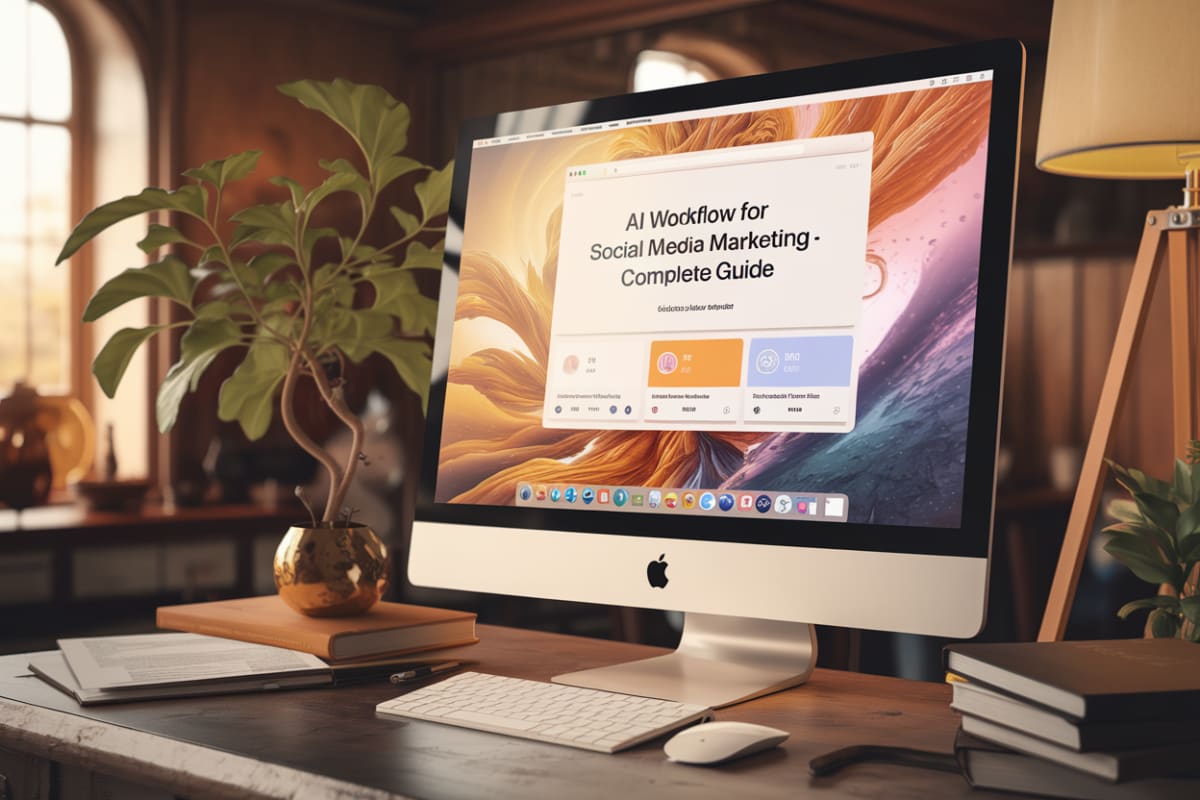How To Improve Your Social Media Marketing
Key Components of a Social Media Marketing Strategy
1. Set S.M.A.R.T. Goals
Establish clear, Specific, Measurable, Achievable, Relevant, and Time-bound goals that align with your overall business objectives. For example, a software company might aim to increase brand awareness by 30% in six months through targeted social media campaigns.
2. Understand Your Audience
Utilize social listening tools to analyze your audience's demographics, interests, and behaviors. This analysis allows you to create content that resonates. For instance, a beauty brand might discover that their audience prefers Instagram over Facebook and tailor their content accordingly.
3. Create Engaging Content
Develop high-quality content that encourages interaction. Use various formats like videos, infographics, and polls to maintain audience interest. For example, Duolingo engaged users by creating entertaining TikTok videos about their mascot's crush on Dua Lipa, leading to increased brand visibility.
4. Leverage Influencer Marketing
Partner with influencers who authentically connect with their audience. For instance, fashion brands can collaborate with micro-influencers who have a loyal following, rather than focusing solely on those with large audiences. This approach typically yields higher engagement rates.
5. Monitor and Analyze Metrics
Track performance using relevant metrics such as engagement rates, click-through rates, and conversion rates. This monitoring helps refine your strategy over time. A study showed that brands using influencer-generated content performed better than those relying on traditional brand-directed content. Additionally, consider tools like the AI Social Media Coordinator from Enrich Labs—this innovative product autonomously moderates and analyzes thousands of comments and DMs, providing actionable insights that enhance your strategy.
6. Adapt to Trends
Keep your strategy dynamic by staying updated on social media trends and platform changes. For instance, incorporating real-time engagement through Instagram Stories or TikTok challenges can significantly boost your reach and engagement.
7. Foster Community Engagement
Engage directly with your audience by responding to comments, asking for feedback, and creating user-generated content campaigns. This engagement builds a loyal community around your brand. For example, Stanley capitalized on a viral moment by engaging with a customer who shared a story about their tumbler surviving a car fire, thus strengthening brand loyalty.
8. Utilize Paid Advertising
Consider running targeted ads to reach a broader audience. For instance, Facebook Ads can be customized to target specific demographics, increasing conversion chances. Reports indicate that businesses with a social media strategy can see a 26% increase in customer retention, underscoring the importance of strategic planning in social media marketing.
These strategies collectively contribute to an effective social media marketing approach that enhances brand visibility while driving customer engagement and loyalty.
Strategies to Increase Social Media Engagement
1. Utilize Hashtags Effectively
Using relevant hashtags can significantly boost your post's visibility on platforms like Facebook and Instagram. For instance, Sprouts Farmers Market leveraged seasonal hashtags like #PumpkinSpice to promote products, generating over 8,000 likes on a single post Source: Hootsuite.
2. Create High-Quality Content
Consistently posting high-quality, relevant content is crucial. This includes using high-resolution images and mixing content formats such as Reels and Stories. Brands that incorporate engaging visuals and informative posts see higher interaction rates Source: Peter Karl.
3. Engage with Your Audience
Encouraging interactions is key. Ask your audience to like, comment, and share your content. Responding to comments fosters a sense of community Source: Zeenews.
4. Optimize Posting Times
Understanding when your audience is most active can vastly improve engagement rates. Use platform analytics to determine optimal posting times Source: Peter Karl.
5. Leverage Emotional Content
Content that evokes strong emotions, particularly negative ones like anger or fear, tends to generate higher engagement. Posts that trigger these emotions often go viral, prompting users to comment and share Source: Jeff Bullas.
6. Collaborate with Influencers
Partnering with influencers helps reach new audiences. Authentic relationships with influencers can significantly boost your brand's credibility and engagement Source: Buffer.
7. Consistency is Key
Regularly posting content helps maintain audience interest. A predictable posting schedule keeps your audience engaged and expecting new content Source: Zeenews.
8. Use Interactive Features
Utilizing features like polls and quizzes on platforms such as Instagram Stories can boost engagement by making followers feel involved Source: Peter Karl.
Implementing these strategies allows brands to create a more engaging social media presence that resonates with their audience.
Overview of Top Social Media Platforms for Marketing
Based on the latest insights and statistics, several social media platforms stand out as the best for marketing in 2024:
Facebook
- Users: Over 3.65 billion monthly active users (MAUs).
- Marketing Strengths: Facebook remains the largest social media platform, making it a prime choice for businesses. It offers robust advertising tools such as Facebook Ads Manager and features like Facebook Groups that help build community engagement. Over 200 million businesses utilize Facebook tools, indicating its effectiveness in reaching a vast audience. Marketers should focus on creating engaging content, as the platform's algorithm favors posts that encourage conversations and interactions.
- Case Study: A small business using Facebook Ads reported a 30% increase in sales over three months by targeting specific demographics using Facebook's detailed ad targeting features Buffer.
Instagram
- Users: Approximately 2.04 billion MAUs.
- Marketing Strengths: Instagram is particularly effective for brands relying on visual storytelling. The platform supports various content forms, including images, videos, Stories, and Reels, making it versatile for showcasing products. Its engagement-driven algorithm makes it crucial for brands to post high-quality, visually appealing content. Instagram also facilitates user-generated content, enhancing brand loyalty and community feel.
- Example: Brands that engage with influencers on Instagram often see higher engagement rates. For instance, a fashion retailer partnered with micro-influencers and reported a 25% increase in website traffic within two months Buffer.
TikTok
- Users: Over 1 billion MAUs.
- Marketing Strengths: TikTok's unique algorithm allows brands to reach younger demographics and engage them through entertaining content. The platform is effective for viral marketing, allowing brands to leverage trending challenges and influencer partnerships to increase visibility. TikTok's advertising features enable brands to create engaging, contextually relevant ads that blend seamlessly with user content.
- Success Story: A beverage brand launched a TikTok challenge that went viral, resulting in a 50% increase in sales during the campaign period, showcasing the platform's potential for explosive brand engagement High Social.
YouTube
- Users: Approximately 2.5 billion MAUs.
- Marketing Strengths: As the second largest search engine, YouTube is essential for video marketing. Brands can create tutorial videos, product reviews, and engaging content that entertains and educates consumers. YouTube ads can target specific demographics and interests, increasing ROI significantly.
- Case Study: An educational institution that used YouTube for marketing saw a 60% increase in enrollment applications after launching a series of informative videos on their programs Buffer.
LinkedIn
- Users: Over 900 million users, primarily professionals.
- Marketing Strengths: LinkedIn is the go-to platform for B2B marketing. It allows businesses to connect with professionals and industry leaders, making it ideal for networking and lead generation. Content such as articles, white papers, and professional updates performs well here.
- Example: A software company utilizing LinkedIn for targeted ads and sponsored content increased its lead generation by 40%, demonstrating LinkedIn's potential for driving B2B sales Buffer.
Frequency of Posting
The frequency of posting on social media varies significantly by platform and is influenced by factors such as audience engagement and content quality.
General Recommendations
- Facebook: Post 1-2 times per day. Facebook's algorithm favors meaningful interactions, so focus on quality over quantity. Brands that post consistently see a higher engagement rate.
- Instagram: Similar to Facebook, 1-2 posts daily are optimal. Leveraging Stories and Reels can increase visibility and engagement. Data shows that accounts posting 3-7 times a week see better engagement rates than those posting less frequently.
- Twitter (now X): Frequent posting is encouraged, with 3-5 tweets per day being a common guideline. Twitter's fast-paced nature means content can quickly become buried, so regular interaction is crucial.
- LinkedIn: For B2B marketing, 2-5 posts per week is effective. Quality, professional content tends to perform well in this space.
- TikTok: Posting 1-3 times per day is advisable to keep up with trends and audience expectations.
Quality Over Quantity
Neil Patel emphasizes the importance of content quality over sheer volume of posts, highlighting that engagement metrics are more crucial than the frequency of posting. He notes that while certain platforms may benefit from multiple daily posts, the overarching principle should be to ensure high-quality content that resonates with the audience (Neil Patel).
Case Study: Buffer's Approach
Buffer, a social media management platform, suggests a tailored posting frequency based on platform specifics and audience analytics. They advocate for a strategic calendar that considers peak engagement times for each platform. Buffer's analysis indicates that brands consistently experimenting and adapting their posting frequency based on performance data achieve superior results (Buffer).
Short-form vs Long-form Content
Both short-form and long-form content have their advantages on social media platforms. Short-form content includes formats like Instagram Reels, TikToks, and Tweets. It caters to quick consumption and is especially effective on platforms that support fast-paced scrolling, such as TikTok (average video length is 42.7 seconds) and X (formerly Twitter), where tweets are limited to 280 characters. According to a Statista study in 2023, TikTok is preferred by 40% of U.S. users for short-form content Hootsuite.
Conversely, long-form content allows for in-depth storytelling and builds deeper connections and trust with audiences. This format often appears in blog posts, YouTube videos, and podcasts. While it may take longer to produce, it can effectively convert social media users into paying customers.
Quality Over Quantity
Neil Patel emphasizes that the quality of content is paramount over its frequency or timing. He notes that content quality is the most critical factor for success on social media Neil Patel.
Emotional Engagement
Content that evokes strong emotions, especially negative emotions like anger, fear, and moral indignation, drives higher engagement on social media. For instance, posts that incite anger or fear can lead to increased shares and comments, significantly boosting engagement metrics. Research indicates that anger-driven content spreads faster, as users feel compelled to react Jeff Bullas.
Instagram Specific Insights
For Instagram, data shows that Reels generate significantly more reach than other post types, outperforming single-image posts by 225% and carousels by 36%. However, carousels achieve higher engagement rates, suggesting that while Reels attract attention, carousels foster more interaction Buffer.
Case Studies
- Duolingo & Dua Lipa: Duolingo successfully created viral content by developing a storyline involving their mascot Duo's crush on Dua Lipa, generating millions of engagements and fostering a strong brand presence on TikTok.
- Stanley Tumbler: A viral moment occurred when a user documented their Stanley tumbler surviving a car fire, leading to significant media coverage and increased brand interest Hootsuite.
In summary, the best-performing content types on social media are a mix of short-form and long-form formats, with quality and emotional engagement playing critical roles in driving interaction and reach.
Key Metrics for Measuring Success
To effectively measure the success of your social media marketing, track several key metrics that align with your business goals. Here are the primary metrics to consider:
1. Engagement Metrics
Engagement metrics include likes, shares, comments, and mentions. These indicators provide insight into how well your content resonates with your audience. Tracking engagement rates on posts helps identify the types of content that generate the most interaction. A case study from Hootsuite showed that brands engaging actively with followers through comments and shares saw a significant increase in audience loyalty and brand awareness, leading to higher conversion rates over time Hootsuite.
2. Reach and Impressions
Reach refers to the number of unique users who have seen your content, while impressions indicate how many times your content has been displayed, regardless of clicks. Monitoring these metrics helps understand your content's visibility and effectiveness. Tools like Hootsuite Analytics allow brands to visualize changes in reach over time, helping identify successful campaigns or posts Hootsuite.
3. Website Traffic
Tracking the number of visitors directed to your website from social media platforms provides valuable insights into the effectiveness of your social media strategy. Google Analytics can show which platforms drive the most traffic and whether that traffic converts into leads or sales.
4. Conversion Rates
Ultimately, the goal of social media marketing is to drive conversions, whether that's sales, sign-ups, or downloads. By setting up conversion tracking through tools like Facebook Pixel or Google Analytics, measure how many users took a desired action after engaging with your social media content Hootsuite.
5. Audience Demographics and Insights
Understanding your audience is crucial for tailoring content. Social media platforms provide analytics tools reporting on audience demographics, interests, and behaviors. Insights about when your audience is most active help schedule posts for maximum engagement Brand24.
6. Sentiment Analysis
Monitoring the sentiment around your brand on social media helps gauge public perception. Tools analyzing sentiment can reveal whether conversations surrounding your brand are positive, negative, or neutral, allowing for proactive reputation management Amplify360.
7. Competitive Analysis
Understanding how your competitors perform on social media offers insights into your strategy. Benchmarking against competitors helps identify gaps in your approach and areas for improvement. Tools like Hootsuite allow you to track competitor performance and measure it against your own Hootsuite.
By regularly tracking these metrics and using analytics tools, brands can refine their social media strategies, improve engagement, and ultimately drive better results.
Common Mistakes in Social Media Marketing
1. Poor Brand Definition and Content Focus
Many businesses jump into social media without a clear understanding of their brand or target audience. This lack of focus leads to content that does not resonate with potential customers, diminishing the effectiveness of their marketing efforts.
2. Unrealistic Expectations of Customer Service
Some brands expect social media to be a quick fix for customer service issues. However, managing customer interactions on social platforms requires a thoughtful approach and consistent engagement. Failing to meet customer expectations can damage the brand's reputation.
3. Ignoring Platform Relevance
Not all platforms suit every business. For example, B2B companies might find LinkedIn more effective than Instagram or TikTok. Companies must choose platforms that align with their target audience and business goals.
4. Choosing the Wrong Platform
Understanding where your target audience spends their time is crucial. For instance, while Facebook is popular among various demographics, Instagram is favored by younger audiences. Misalignment can lead to wasted marketing efforts.
5. Lack of Strong Communication Skills
Effective communication on social media requires more than just being able to write. Brands need a strategic approach to storytelling and engagement, which can include video production capabilities in today’s market.
6. Failing to Integrate Social Media into an Overall Strategy
Social media should not exist in a vacuum. It needs to be part of a broader marketing strategy that includes traditional marketing efforts to ensure a cohesive brand message and maximized impact.
7. Neglecting Analytics for ROI Measurement
Without analyzing performance metrics, businesses lose the opportunity to refine their strategies and improve their ROI. Tools like Google Analytics and Hootsuite provide insights into what works and what doesn’t.
8. Inconsistent Brand Messaging
Maintaining consistent messaging across all digital platforms is vital. Inconsistent communication can confuse audiences and erode trust, making it harder to establish a strong brand identity.
9. Underestimating the Value of Content Marketing
Content marketing is essential for engaging audiences. Without a robust content strategy, brands may struggle to connect with their target audience, resulting in lower engagement and visibility.
10. Not Leveraging Social Media Features
Many brands overlook the latest features offered by social media platforms, like Instagram Reels or TikTok trends, which can significantly enhance visibility and engagement. Embracing these tools is key to staying relevant in a crowded space.
These common pitfalls can significantly hinder the effectiveness of social media marketing strategies. By avoiding these mistakes, businesses can better engage with their audiences and achieve their marketing goals more effectively.
For a more streamlined approach to managing your social media interactions, consider the AI Social Media Coordinator from Enrich Labs. Experience 70%+ cost savings while ensuring a consistent brand voice and faster response times. Learn more about how it can transform your social media marketing efforts here.




